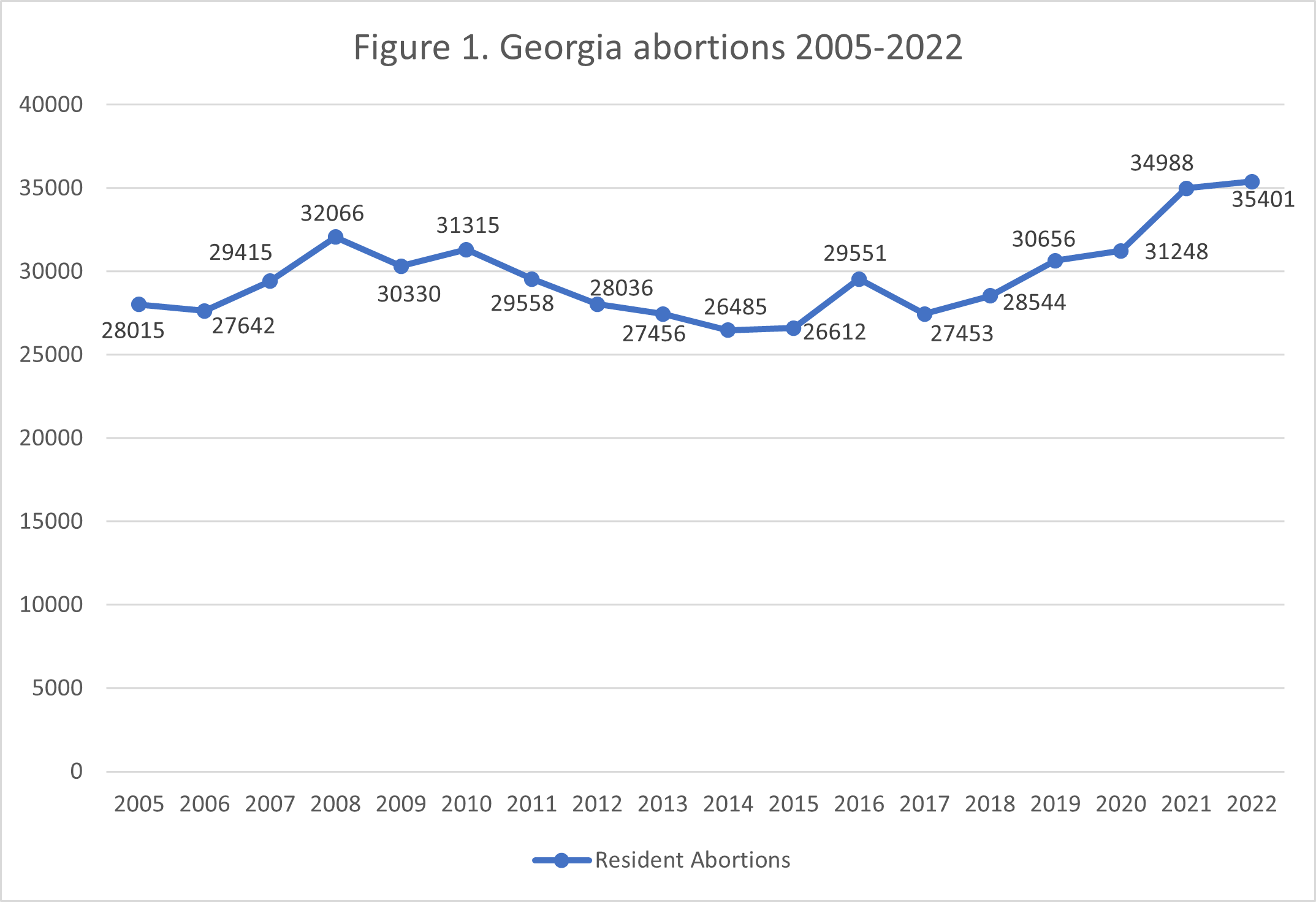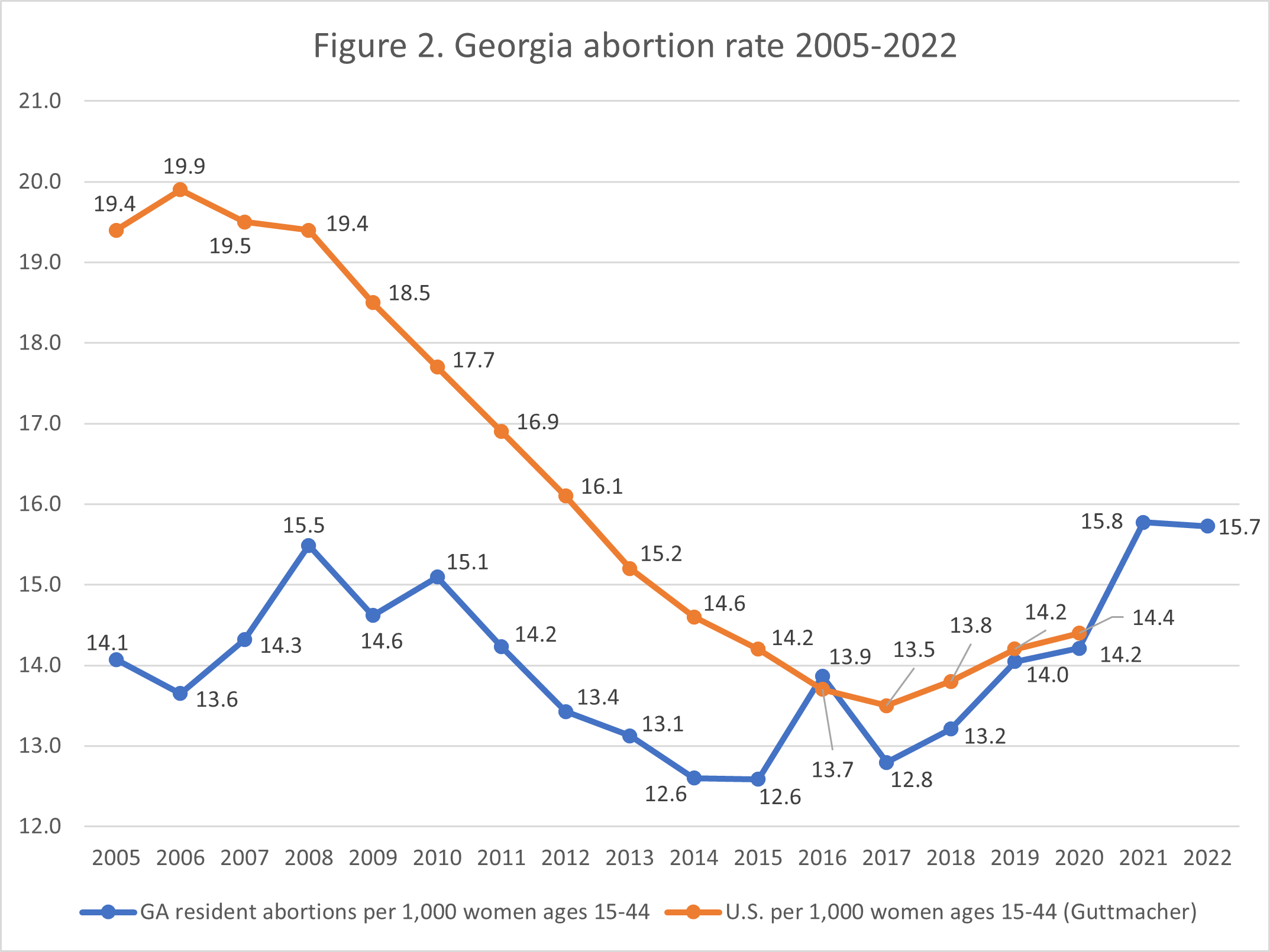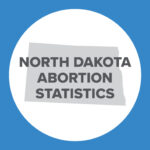Abortion Reporting: Georgia (2022)
Georgia released its 2022 abortion statistics through its online vital statistics database in August 2023. The data showed that resident abortions increased from the previous year.
Statistics and Changes in Georgia Abortions, 2021-2022

The report does not include information on Planned Parenthood’s Georgia abortion market share.
Abortion Totals and Trends
In 2022, there were 35,401 abortions reported to have been performed on Georgia residents, both inside and outside Georgia. This was an increase of 1% from 2021 when 34,988 Georgia resident abortions were reported (Fig. 1). Georgia did not report the number of chemical abortions performed on residents. The Charlotte Lozier Institute (CLI) estimates that Georgia’s 2022 abortion rate was 15.7 abortions per 1,000 women ages 15 to 44, similar to the previous year (Fig. 2).1 As of October 2023, 23 states have released 2022 abortion statistics, of which 13 (including Georgia) reported that abortions increased.
Georgia’s abortion data is available in OASIS (an online state database), which includes abortions performed on Georgia residents in Georgia and other states but does not include abortions performed in Georgia on nonresident women. Separately, CLI requested data on all abortions occurring in Georgia from the Georgia Department of Public Health (DPH). In 2022, according to the data received, there were 39,067 abortions reported in Georgia, of which 70% were chemical.
State Report Summary
Seven percent of Georgia resident abortions were performed on girls in their teens or younger, with 2% performed on girls between the ages of 10 and 17 and 5% on girls between the ages of 18 and 19. Twenty-seven percent were on women in their early twenties, and 30% were on women in their later twenties. Thirty-two percent were obtained by women in their thirties, and 4% by women ages 40 to 55.
In 2022, 63% of Georgia resident abortions were performed on black women. Just under a fifth (19%) of the abortions were on white women, and 3% were on Asian women. There were 110 abortions (0.3%) on American Indian or Alaska Native women, and there were 48 abortions (0.1%) on Native Hawaiian or other Pacific Islander women. Two percent of the abortions were obtained by multiracial women. Race was not reported for 12% of abortions. The black resident abortion rate (27.0 abortions per 1,000 women ages 15 to 44) was nearly five times the white abortion rate (5.5) in 2022.
In 2022, 84% of Georgia resident abortions were performed on non-Hispanic women, 10% were on Hispanic women, and 6% were on women of unknown ethnicity.
Occurrence Data
Upon request, the Georgia Department of Public Health (DPH) provided CLI with data on abortions occurring in the state in 2022. According to this data, 39,067 abortions were performed in Georgia in 2022. Many of the demographic trends associated with the occurrence data mirrored those associated with the residence data. For example, sixty-four percent of all abortions occurring in the state were performed on black women, and 57% were obtained by women in their twenties.
Unlike the residence data, the occurrence statistics sent by DPH did provide data on the educational level and marital status of women who had abortions in Georgia. Eighty-six percent of women who had an abortion in Georgia were not married, while 10% were married, and 4% were on women of unknown marital status. The majority of abortions (54%) that occurred in Georgia were on women with some college or a completed degree of some kind. Thirty-six percent of women had a high school diploma or GED, while 8% had not completed high school. Two percent of Georgia abortions were on women whose educational level was not reported.
The occurrence data provided by the Georgia DPH also included information on abortions by gestational age. In 2022, 60% of Georgia abortions occurred at six weeks of gestation or before. Thirty-one percent occurred between seven and 10 weeks of gestation and 5% occurred between 11 and 13 weeks of gestation. Three percent occurred between 14 and 17 weeks, while 1% occurred between 18 and 20 weeks of gestation. One hundred and twenty-three abortions or 0.3% occurred at 21 to 22 weeks of gestation, with 122 being performed at 21 weeks and one abortion being performed at 22 weeks of gestation.
Also, unlike the resident data made available by the state’s OASIS dashboard, the occurrence data provided by the state to CLI detailed the number of abortions by procedure type. In 2022, 70% of Georgia abortions were performed using chemical abortion while 29% were surgical. One percent of Georgia abortions were performed via an unknown procedure.
Lastly, Georgia’s 2022 occurrence data provided information on abortions by state of residence. Georgia women obtained 79% of the abortions that occurred in the state and Alabama women obtained 8%. South Carolina and Tennessee women obtained 4% and 3%, respectively, and both Texas and Mississippi women obtained 1%. The remaining abortions were obtained by women from a variety of different states.
Informed Consent
Every year, as a requirement of Georgia’s “Woman’s Right to Know Act,” the state’s Department of Health releases an annual summary report of parental consent and informed consent data for abortions that occur in the state. Georgia’s 2022 annual report was published in May 2023 and summarized aggregate data regarding parental consent and informed consent. In 2022, 382 parents or guardians were notified regarding their minor daughter seeking an abortion. Of the 382 parents notified, 239 had minors who went on to obtain an abortion, while two minors obtained an abortion via a judicial waiver, not parental consent. The numbers of women (of all ages) who were provided information regarding the risks of abortion, the gestational age of the unborn child, and other medical information (16,514 women) and information on the assistance available to pregnant women (17,359 women) were far lower than the number of resident women who obtained abortions in Georgia (35,401 abortions) and the number of abortions that occurred in Georgia in 2022 (39,067 abortions).
Legislative Changes
As CLI has previously noted, after Roe v. Wade was overturned in June 2022, Georgia’s 2019 heartbeat law went into effect on July 20, 2022 after being previously blocked from enforcement. However, the law was blocked again on November 15, 2022. The law went back into effect eight days later and remains in effect while litigation continues.
State Ranking
In CLI’s 2016 paper on abortion reporting across the country, Georgia’s reporting tied for 25th best. To improve its reporting, Georgia could include in its state report all the information it provides to the CDC, including the pregnancy history and marital status of women getting abortions, the gestational ages at which abortions were performed, and the types of abortion procedures used. Georgia could also include data for all abortions performed in the state and identify the states that share abortion data with Georgia.


- National rates were calculated by the Guttmacher Institute. Georgia rates were calculated by CLI using the following formula: (abortions performed on Georgia residents ÷ number of resident women ages 15-44 [based on most recent population estimates]) x 1,000. Rates may differ slightly from previous CLI articles due to revised population estimates. Population estimates were obtained from the CDC WONDER database. Estimates for 2005-2009 are intercensal estimates of the July 1 resident population. Estimates for 2010-2019 are Vintage 2020 postcensal estimates of the July 1 resident population. Estimates for 2020-2022 are Vintage 2022 postcensal estimates of the July 1 resident population. Estimates were produced by the U.S. Census Bureau and the National Center for Health Statistics.



























